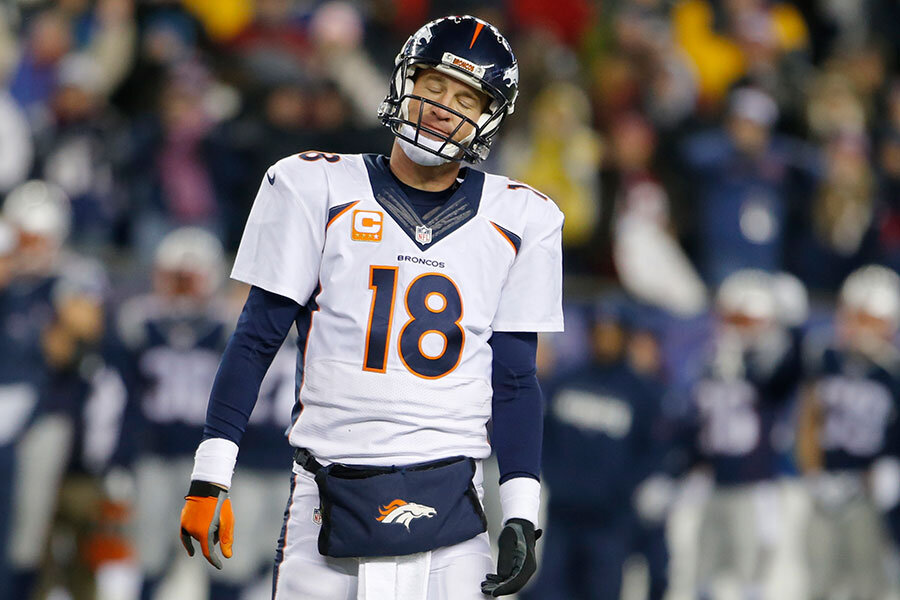The beautiful mind of Peyton Manning
Loading...
Perhaps the best thing about Peyton Manning was “Peyton Manning face.”
Google it. There he is, his acres of forehead wrinkled quizzically, his lips pursed in a look that conveys all the joy of sucking on a radial tire.
It was the look Manning gave whenever all his meticulous preparations came crashing down.
Forget the 200 career wins. The 55 touchdown passes in a season. The five Most Valuable Player Awards.
Those records will someday all be broken. No, it was Peyton Manning face that changed football as we know it.
In all likelihood, it will not make an appearance at his news conference Monday, when he retires from the Denver Broncos after 18 years in professional football. But it should.
That’s because it was the one time we got to see inside Manning’s head. Granted, it was when everything wasn’t going according to plan. But at least it was a brief window into perhaps the most remarkable mind of any player in National Football League history.
It was a visual clue of how utterly invested Manning was in the cerebral side of football. It wasn’t a helmet-tossing anger or a resigned capitulation. It was an existential angst at having been checkmated.
Most of the time, when things were going well, Manning was about as expressive as a bank teller back from his lunch break. But his play was so remarkable that there was something dumbfounding in it.
“How did he do that?” is a common refrain in sports.
“How did he think that?” is less common and the essence of Manning’s unparalleled career.
In basketball, Stephen Curry can divine from the shifting geometry of the game the moment everything is aligned for a pass or a shot that strains credulity and Newton’s laws.
But there is precious little improvisation about football. You have three seconds to execute a play or to have your head wall-mounted by a blitzing linebacker. You either know what’s going to happen, or you hand the ball to the referee and pull the clod of turf out of your face mask.
More often that any fan had any right to expect, Manning knew what was going to happen.
At the height of his powers with the Indianapolis Colts, Manning’s offense was essentially a Chevelle with a 90 degree V8 Ferrari engine.
The playbook was shockingly simple. A relative handful of plays. The entire enterprise rested on Manning’s ability to look at the defense and choose the right play.
Among all the numbers compiled by Manning, perhaps the single most telling was 3.13. That was his sack rate – also (tied) for an all-time record. That means Manning was sacked on 3.13 percent of his dropbacks.
This for a man who moved with all the speed and grace of a woolly mammoth.
Manning never took sacks not because of any natural gift. He never took sacks because the ball was usually gone by the time defenders arrived.
He knew what was coming.
So how did he do it?
His backup for the Denver Broncos, Brock Osweiler, called it a “photographic memory” in a 2014 interview with The New York Post. He recalls Manning remembering a single blitz that he saw in 2004 – and then not again until 2012.
“Photographic memory” might be a little too “Good Will Hunting.” “Seared into memory by hours and hours of painstaking film study” is probably more accurate.
In Manning’s many notebooks, he unlocked the modern NFL.
He is the man around whom the NFL’s passing revolution pivoted. When Manning entered the league in 1998, football was still the recognizable descendant of “three yards and a cloud of dust.” Teams still won by running the football and stopping the run.
Following Manning’s lead, the NFL has now turned that mantra on its head. Manning put up “Star Wars” numbers, in the words of the Colts owner, and the NFL wanted in on the entertainment. It changed its rules, and the basic paradigm underlying the game changed.
To win, you now pass the ball and stop the pass.
This past year, the Broncos won the Super Bowl by, ironically, fulfilling the second half of that equation, not the first.
Manning is retiring because the taskmaster of his mind no longer has an equal partner in his body after four neck surgeries that threatened his career in 2011. Last season was his worst as a pro, but the Broncos succeeded by building a pass rush that liquefied opposing quarterbacks.
For 17 years, Manning was famous for starving his backups of practice time; he wanted every moment to perfect every detail. This year, he was briefly relegated to being a backup.
For 17 years, Manning rarely played in a professional football game that he was not personally tasked with winning. This year, he was tasked simply with not losing.
The Ferrari mind was now driving a Chevelle offense.
But in the diminution of the player was a notable change in the man.
Peyton Manning face was the face of man asked to do everything – by his flawed teams and by his own exacting standards.
In accepting a supporting role on a Super Bowl-winning team, and ultimately in retiring from the game he reshaped as Grand Master, Peyton Manning showed that the last lesson he learned as an NFL quarterback was the most un-Peyton-Manning-like of all.
He learned to let go.






